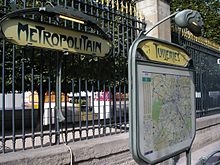Tuileries (Métro Paris)
|
|
|
|---|---|

|
|
| Tariff zone | 1 |
| Line (s) |
|
| place | Paris I |
| opening | July 19, 1900 |
Tuileries is an underground station on Line 1 of the Paris Métro .
location
The metro station is located in the 1st arrondissement of Paris , on the border of the district Quartier de la Place Vendôme and St Germain l'Auxerrois. It lies lengthways below the Rue de Rivoli .
Surname
It is named after the adjacent Jardin des Tuileries . It was laid out as the park of the Palais des Tuileries , the city palace of the French kings, built from 1564 and destroyed by fire in 1871. Before it was built, there were brick factories (fr: Tuileries) on the site .
history
The station went into operation on July 19, 1900 with the opening of Line 1 from Porte de Vincennes to Porte Maillot . It was built using the cut-and- cover method and was initially 75 m long. At the beginning of the 1960s, the station was extended to 90 m and converted for traffic with rubber-tired trains .
In 1963 the side walls were clad with curved panels , and in 2000 the station was restored to its original cross-section. At the end of 2008, the platforms were raised in the course of the introduction of driverless operation on Line 1 and provided with platform screen doors.
description
In contrast to the elliptical cross-section, which is more common in Paris , the station has a horizontal metal ceiling. Longitudinal girders, which carry small vaults made of bricks, rest on iron support beams that are perpendicular to the direction of travel. The ceiling of the extension from the 1960s has the shape of a vault.
The station has two 4.10 m wide side platforms on two main tracks. The two entrances are at their southeastern end, on the park side of Rue de Rivoli at the level of Rue du 29 Juillet.
vehicles
Initially, trains ran on Line 1, which consisted of a railcar with only one driver's cab and two sidecars . These vehicles were two-axle and each nearly nine meters long. As early as 1902, eight-car trains were formed, each with a railcar at the ends of the train. The railcars were replaced by four-axle vehicles on bogies until 1905, and the sidecars from 1906 . In 1908, green painted five-car trains of the Sprague-Thomson design entered Line 1, which stayed there until the 1960s. From May 1963, the Sprague-Thomson trains, which ran on rails, were successively replaced by the MP 59 series with rubber-tyred vehicles , until December 1964 there was mixed traffic of the two modes of operation. The MP 89 CC series followed in 1997, which gave way to the MP 05 series with the start of automatic operation .
Surroundings
Remarks
- ^ After the metro accident at Couronnes station in August 1903, both railcars ran one behind the other at the Zugspitze
- ↑ Unlike usual, the trains on Line 1 were painted light gray (with a red 1st class car) from the early 1930s
- ↑ CC means "Conduite Conducteur" (driver-controlled), in contrast to the driverless type MP 89 CA
literature
- Gérard Roland: Stations de métro. D'Abbesses à Wagram . Bonneton, Paris 2003, ISBN 2-86253-307-6 .
Web links
Individual evidence
- ^ Gérard Roland: Stations de métro d'Abbesses à Wagram . Christine Bonneton, Clermont-Ferrand 2011, ISBN 978-2-86253-382-7 , pp. 207 .
- ^ Brian Hardy: Paris Metro Handbook . 3. Edition. Capital Transport Publishing, Harrow Weald 1999, ISBN 1-85414-212-7 , pp. 36 .
- ↑ a b Jean Tricoire: Un siècle de métro en 14 lignes. De Bienvenüe à Météor . 2nd Edition. La Vie du Rail, Paris 2000, ISBN 2-902808-87-9 , p. 130 f .
- ↑ Jean Tricoire: op. Cit. P. 134.
- ^ Mark Ovenden: Paris Underground - The maps, stations, and design of the métro . Penguin Books, New York 2009, ISBN 978-0-14-311639-4 , pp. 171 .
- ↑ Jean Tricoire: op. Cit. P. 132 ff.
| Previous station | Paris metro | Next station |
|---|---|---|
|
Concorde ← La Defense |
|
Palais Royal - Musée du Louvre Château de Vincennes → |
Coordinates: 48 ° 51 '53.2 " N , 2 ° 19' 43.9" E
